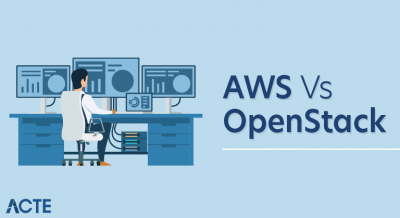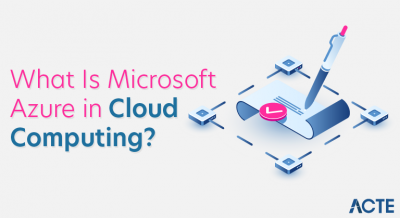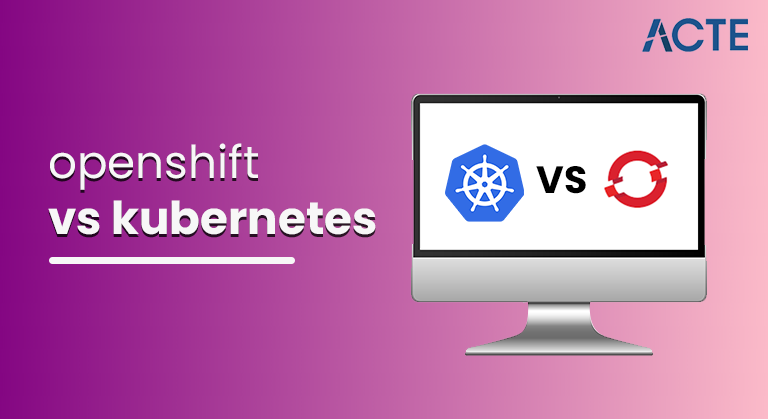
OpenShift is a commercial product, while Kubernetes is an open-source project. An OpenShift subscription enables users to get paid support and Kubernetes offers a self-support model.
- Introduction of Openshift vs Kubernetes
- What is Kubernetes?
- Features of Kubernetes
- Why Choose Kubernetes?
- Advantages of Kubernetes
- What is OpenShift?
- Features of OpenShift
- Why Choose OpenShift?
- Advantages of OpenShift
- OpenShift vs. Kubernetes
- Making the Decision: Kubernetes or OpenShift
- Conclusion
Introduction of Openshift vs Kubernetes
Most manufacturing environments have commenced the use of bins as they’re without difficulty scalable, cost-effective, higher than digital machines, and quicker deployable. Of course, it’s far less difficult while operating with 10-20 bins however believe in case your manufacturing surroundings of a Kubernetes cluster has masses of bins. It turns into difficult to manipulate the field lifecycle with more than one bins strolling in parallel. That is why you want a field orchestration platform/device to manipulate all of the automatic deployment, scaling, organizing, and control of bins.Comparing Kubernetes with OpenShift might now no longer be truthful as those field orchestration gear are unique projects. Kubernetes is an open-supply project, whilst OpenShift is a made from Red Hat offerings. Comparing Kubernetes with OpenShift is like evaluating an engine of a automobile with a automobile. This is due to the fact Kubernetes itself is the center a part of the general OpenShift architecture.
- Kubernetes is an open-supply field as a provider platform (CaaS) that may automate deploying, scaling, and dealing with containerized apps to hurry up the improvement procedure. Originally advanced at Google, the product turned into later exceeded over to the Cloud Native Computing Foundation beneathneath the Linux Foundation.
- Many cloud offerings generally tend to provide a version of a Kubernetes primarily based totally platform or infrastructure as a provider. Here, Kubernetes may be deployed as a platform-imparting provider, with many companies imparting their personal branded distributions of Kubernetes.
What is Kubernetes?
- Storage Orchestration: Allows Kubernetes to combine with maximum garage systems, which includes AWS Elastic Storage.
- Container Balancing: IT permits Kubernetes to calculate the first-class place for a box automatically.
- Scalability: Kubernetes permit horizontal scaling. This setup lets in for companies to scale out their garage, relying on their workload requirements.
- Flexibility: Kubernetes may be run in more than one environments, along with on-premises, public, or hybrid cloud infrastructures.
- Self-Monitoring: Kubernetes presents tracking skills to assist test the fitness of servers and containers.
Features of Kubernetes
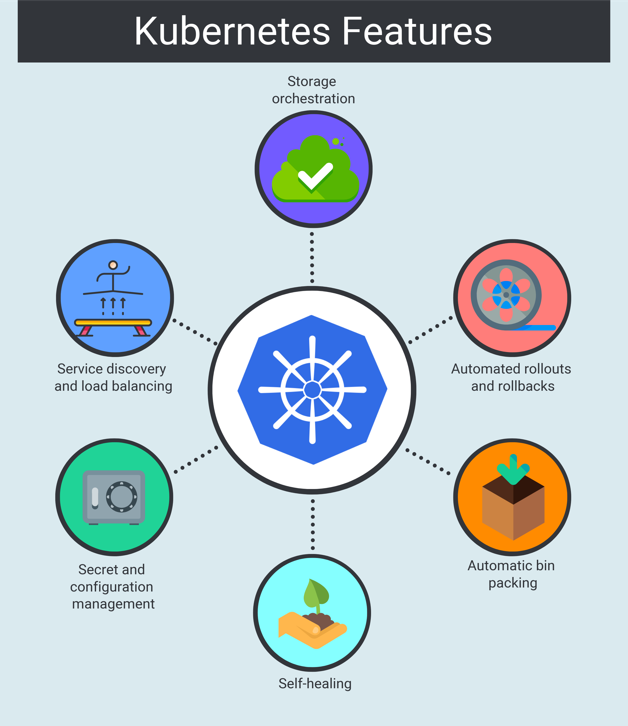
Why Choose Kubernetes?
A huge a part of the enterprise prefers Kubernetes because of the subsequent reasons:
1. Strong Application Support – Kubernetes has introduced guide for a extensive spectrum of programming frameworks and languages, which allows it to fulfill a number of use cases.
2. Mature Architecture: The structure of Kubernetes is favored due to its affiliation with Google’s Engineers, who’ve labored at the product for nearly ten years.
3. Developmental Support: Because Kubernetes has a huge and lively on-line person network, new functions get introduced frequently. Additionally, the person network additionally gives technical guide that encourages collaborations.
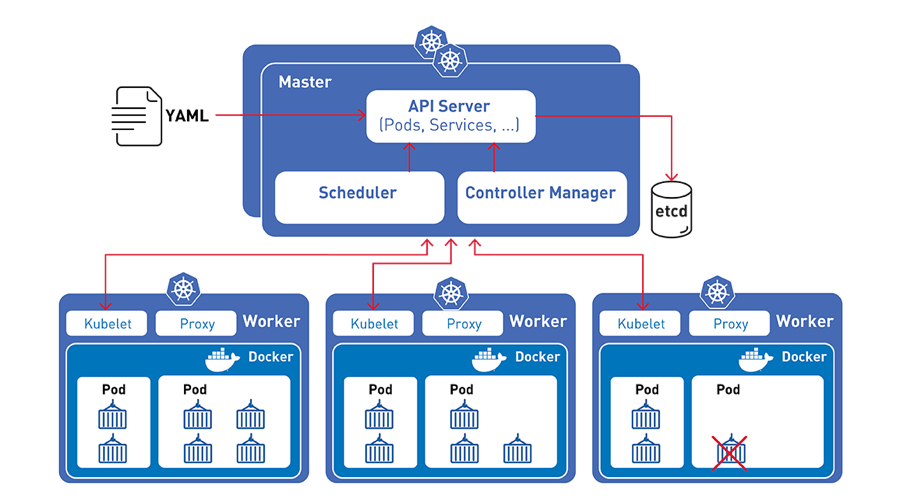
- Since it’s far open-source, it’s far unfastened to apply for any platform It has a big lively network of builders and engineers, which facilitates in freeing new functions continuously.
- You can rollback and rollout without problems to address the downtime automatically.
- For community site visitors distribution, it gives load balancing capabilities.
- It helps one-of-a-kind programming languages and frameworks, which offers flexibility to builders and administrators.
- It facilitates in utilising the infrastructure assets very efficaciously and decreasing the general cost.
- It comes with a default dashboard that gives a ton of records to apprehend the whole thing approximately the cluster.
Advantages of Kubernetes
- OpenShift is likewise a containerization software program solution, owning an Apache License. Developed via way of means of Red Hat. Its unique product is the OpenShift field platform, a Platform-as-a-Service (PaaS), which may be controlled via way of means of Kubernetes. Termed because the ‘Enterprise Kubernetes,’ this system is written in a aggregate of each Go and AngularJS languages. Its number one characteristic lets in builders to install and increase apps without delay at the cloud. It additionally appends gear over a Kubernetes middle to quicken the process.
- A sizeable alternate got here with the current creation of OpenShift V3 (launched October 2019). Before the discharge of this version, custom-advanced technology needed to be used for field orchestration. With V3, OpenShift introduced Docker as their high field technology, and Kubernetes because the high field orchestration technology, a good way to be persisted in next releases.
What is OpenShift?
Features of OpenShift
1. Compatibility: As a part of the licensed Kubernetes program, OpenShift has compatibility with Kubernetes box workloads.
2. Constant Security: OpenShift has protection tests which are constructed into the box stack.
3. Centralized coverage management: OpenShift has a unmarried console throughout clusters. This manipulate panel affords customers with a centralized location to enforce policies.
4. Built-in Monitoring: OpenShift comes with Prometheus, that is a devops database and alertness tracking tool. It permits customers to visualise the packages in real-time, the use of a Grafana dashboard.
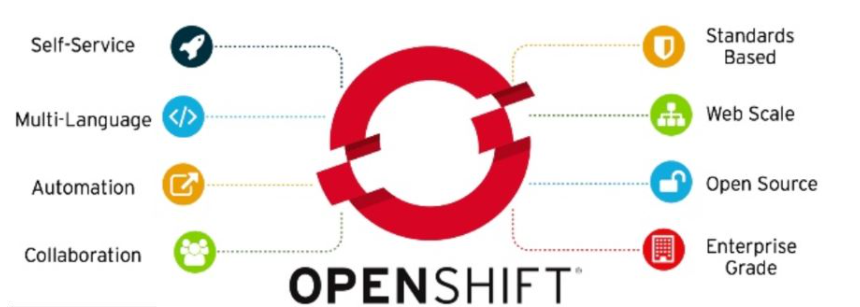
Why Choose OpenShift?
- Self-carrier Provisioning: OpenShift offers customers with the functionality of integrating the equipment they use the most. For instance, due to this, a online game developer can use OpenShift at the same time as growing games.
- Faster Application Development: Can circulate and automate the complete field control process, which in flip complements the DevOps process.
- No dealer lock-in: Provides a dealer-agnostic open-supply platform, permitting customers emigrate their personal field approaches to different working structures as required while not having to take any more step.
Popular purpose customers decide on OpenShift are highlighted below:-
- It helps open box initiative (OCI) for box web website hosting and runtime.
- It consists of masses of fixes to security, defect, and overall performance issues.
- It can construct and install the utility quicker with agility.
- It is simple to combine with many different DevOps tools.
- It validates a couple of third celebration plugins for each release.
- Using a unified console on Red Hat, it is able to fast put into effect and put in force policies.
- It helps Prometheus and Grafana, which facilitates in tracking the cluster.
- It may be without difficulty used with any cloud issuer or at on-premises.
Advantages of OpenShift
- The maximum essential distinction among Kubernetes and OpenShift is that Kubernetes is an open-supply project, and OpenShift is an enterprise-degree business product. This method that Kubernetes is a self-supported tool. In case any difficulty or malicious program is recognized on this tool, human beings attain out to the Kubernetes community, which includes many builders, administrators, architects, etc., to troubleshoot the difficulty.
- Whereas in OpenShift, you get an excellent paid guide alternative for troubleshooting any difficulty with this Red Hat product subscription. With an OpenShift subscription, you could additionally control the public, personal and digital infrastructure thru Red Hat CloudForms.
- The deployment of an software withinside the manufacturing surroundings is a critical degree of the DevOps technique, and OpenShift makes it very easy. It routinely takes care of each step from improvement to deployment, so that you don’t must fear approximately every step withinside the CICD pipeline to do matters manually. So whilst a beginner, you may experience very snug the use of OpenShift to execute a CICD pipeline for software deployment. In OpenShift, the deployment is finished the use of the DeploymentConfig command.
- On the opposite hand, deployment in Kubernetes is complicated and frequently finished most effective via way of means of an expert. You will must installation each step of the pipeline for software deployment manually. Deployment gadgets are used withinside the case of Kubernetes deployments, and they could cope with a couple of concurrent updates.
- In Kubernetes, you could control the cluster the use of the default dashboard initially. But due to its restrained functions and fundamental consumer interface, because the cluster length grows, you may must upload greater superior equipment consisting of Istio, Prometheus, Grafana to control the cluster with ease.
- Red Hat OpenShift gives a consumer-pleasant dashboard to control the cluster. The net console of OpenShift presents competencies to carry out a few superior operations at the cluster for higher management. OpenShift additionally shows integrating the cluster with the EFK stack and Istio. And finally, the to be had ansible playbooks and installer in OpenShift facilitates you control the cluster smoothly.
- Whether it’s miles virtualized or naked metal, a cluster can have a couple of digital machines inside it. In Kubernetes, the addition of digital machines takes a whole lot of time. It calls for builders to create YAML scripts for it.
- Whereas in OpenShift, scaling is effortless. OpenShift can convey up the digital machines into the cluster quicker with the to be had installers and Ansible playbooks. In addition, the technique of scaling in OpenShift is straightforward.
- Kubernetes comes with a whole lot of flexibility as there’s no constant manner of operating with it. You can use any working gadget with greater obstacles to run Kubernetes. Kubernetes has helped many businesses pop out in their legacy architectures as they have been quite previous and did now no longer meet the contemporary marketplace needs.
- You can’t use all of the working structures whilst you are operating with OpenShift. You can most effective use Red Hat distributions, FedoraOS, and CentOS with OpenShift.
- The safety guidelines in OpenShift are stricter in contrast to Kubernetes. For example, OpenShift does now no longer permit you to run the packing containers as root. It additionally restricts the customers from the use of many respectable photos gift on DockerHub. So, whilst operating with OpenShift, you may want to study its safety guidelines first. But due to those restrictions, the authentication and authorization in OpenShift are greater dependable than Kubernetes.
- Whereas in Kubernetes, putting in right authentication and authorization functionality might take a whole lot of effort. Unlike OpenShift, Kubernetes clusters will have many susceptible docker photos if field scanning equipment aren’t incorporated into the cluster. Kubernetes gives role-primarily based totally get entry to manipulate (RBAC) functions, however that isn’t sufficient for the superior degree of safety required in manufacturing environments. So, as in comparison to OpenShift, a whole lot of safety enhancements are but to take place in Kubernetes.
- To carry out all of the cluster management work, you want a appropriate and smooth-to-use net interface. And that is what OpenShift gives. It has a easy login for each consumer, and after logging in, it offers the whole visualization of the cluster, which could be very smooth to understand. Red Hat’s OpenShift has a consumer-pleasant net console that lets in the DevOps engineers to execute Kubernetes duties and the operation groups to display the software comfortably. The manipulate has a couple of alternatives like build, deploy, update, scale, expose, etc., which may be carried out with only a click on of a button.
- Kubernetes comes with a fundamental dashboard that may most effective assist you with fundamental duties. In addition, the dashboard isn’t very consumer-pleasant in comparison to different dashboards to be had withinside the marketplace. That is why DevOps engineers might opt to combine the default Kubernetes dashboard with different visualizations equipment like Prometheus and Grafana.
OpenShift vs. Kubernetes
Yet, there are different essential technical variations defined withinside the desk below:-
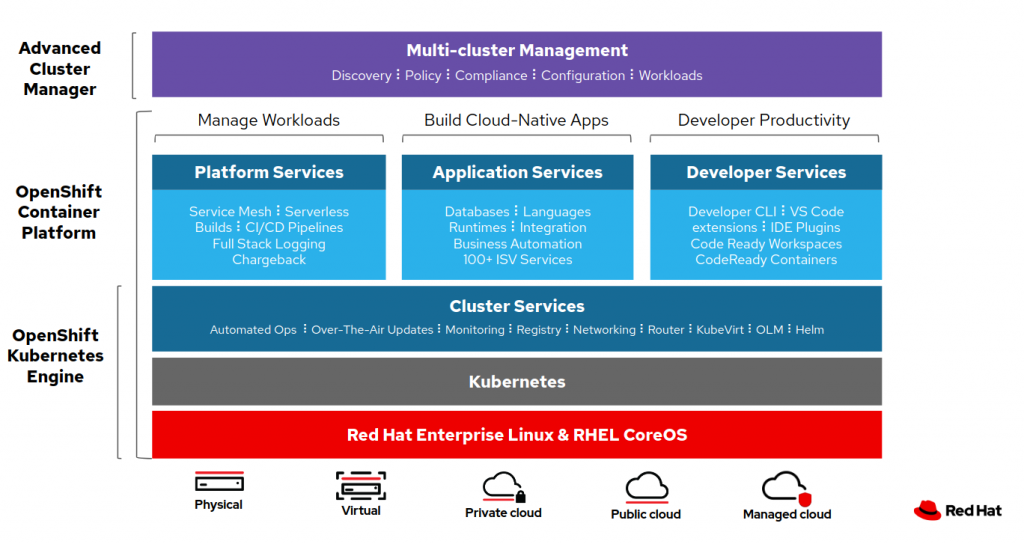
Open Source vs. Commercial:
Deployment:
Management:
Scalability:
Flexibility:
Security:
Web Interface:
Making the Decision: Kubernetes or OpenShift
1. Which one you make a decision to apply will come right all the way down to the necessities of your gadget and the utility you’re building.
2. The query to invite withinside the Kubernetes vs. OpenShift debate is identifying what functions take precedence: Flexibility or an incredible internet interface for the improvement process? Notwithstanding IT experience, infrastructure, and understanding to address the complete improvement lifecycle of the utility.
3. Want extra information? Connect with us, and permit us to help you in containerizing your improvement processes.
- That changed into all approximately Kubernetes, OpenShift, and their differences. Both field orchestration structures are in call for withinside the IT industry. So, relying for your requirement, you may pick the best-proper field orchestration platform to your organization.
- You have to go along with Kubernetes in case you want flexibility together along with your projects. But if you may comply with a described method and need to apply a field orchestration platform quite simply of deployment and management, OpenShift is a higher choice. And when you have been withinside the DevOps area for the beyond few years, you may attempt your good fortune with Kubernetes. But if you are a beginner, pick OpenShift because it will make maximum of the matters quite trustworthy for you.
Conclusion



